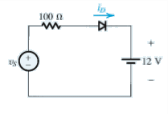Test: The Ideal Diode - Electrical Engineering (EE) MCQ
10 Questions MCQ Test - Test: The Ideal Diode
Consider an AC sine wave voltage signal being used to connect a diode and a resistor as shown in the figure. The variation of the voltage across the diode (Vd) with respect to time (t) is given by

The figure below shows a circuit for charging a 12-V battery. If Vs is a sinusoid with 24-V peak amplitude, the fraction of each cycle during which the diode conducts is

For the connections shown below, the equivalent logic gate is
For the connections shown below, the equivalent logic gate is
The figure below shows a circuit for an AC voltmeter. It utilizes a moving-coil meter that gives a full-scale reading when the average current flowing through it is 1 mA. The moving-coil meter has a 50-Ω resistance. The value of R that results in the meter indicating a full-scale reading when the input sine-wave voltage VI is 20 V peak-to-peak is
The units frequently used to measure the forward bias and reverse bias current of a diode are



















